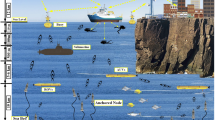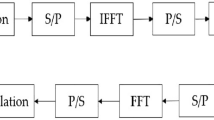Abstract
In underwater environment, getting the desired data through deployed sensor nodes sometime becomes uncouth due to unavoidable circumstances and demands the stringent maintenance specially for energy source. All sensor nodes are battery dependant and in underwater harsh environment it is extremely hard for replacement or recharge the energy sources. The primary goal of such an underwater wireless network is to keep the network running for as long as feasible, and this can only be accomplished by using energy-efficient sensor nodes. To achieve this goal there is only way to design a shrewd underwater data packet routing strategy. After a meticulous research this goal has been achieved by developing a confined energy depletion (CED) opportunistic routing (OR) mechanism. The proposed solution is called an open-ended solution of low energy packets in underwater routing. The entire operation is accomplished in four steps; in first step, the source nodes locate the available routs by broadcasting the packets towards neighbouring node and maintain the relay forwarding node. In second step, the eligibility of the broadcast packets and the nodes have been determined by computing the Node Depth Factor (Ndf). In third step, the adequate communication link selection process between source and the relay node has been carried out by a predefined Threshold Criterion parameter tc. Further, the communication link has been scrutinized by the Accepted Link Quality (ALQ) value and records the links data a Link Corpus Table (LCT) which manages and quantify the communication links by computing the Link Factor Estimator (LFE) and Signal-to-Noise Ratio (SNR) with a distance factor AΔ. In the fourth step, if the ALQ value becomes shorter than AΔ, the link is not suitable to rout the data packets and the next link will be determined on the same criteria until the adequate link is found, and the packet will be forward using this link. The performance measurements are ratified by conducting the simulation in NS2 simulator with AquaSim 2.0 and all results are being compared with DBR, GEDAR, H2DAB, and FBR protocols in terms of Data packet diffusion ratio, Point to point latency, System energy utilization, and Network lifespan. The result statistics showed that CED-OR has performed scrumptiously as: in terms of packet diffusion ratio, the output results are 98%. For point-to-point latency when reaching to 400 nodes, the data packet latency is only marked by 1.7 s. Considering the system energy utilization, at 400 nodes it has consumed only 310 J of energy. Finally, while focusing to the network lifespan when 500 transmission rounds were completed, it was still alive with 450 more life seconds whereas rest of the protocols were just going to die completely.







Similar content being viewed by others
Data Availability
All related data and original images have been placed on Mega cloud storage (https://mega.nz/folder/yVtURCLC) for a limited time in accordance with the Mega.nz policies, however access may only be granted on reasonable request.
References
Guan, Q., Ji, F., Liu, Y., Yu, H., & Chen, W. (2019). Distance-vector-based opportunistic routing for underwater acoustic sensor networks. IEEE Internet of Things Journal, 6(2), 3831–3839. https://doi.org/10.1109/JIOT.2019.2891910
Su, Y., Fan, R., Fu, X., & Jin, Z. (2019). DQELR: An adaptive deep q-network-based energy- and latency-aware routing protocol design for underwater acoustic sensor networks. IEEE Access, 7, 9091–9104. https://doi.org/10.1109/ACCESS.2019.2891590
Ashraf, S., Muhammad, D., Khan, M. A., & Ahmed, T. (2020). Fuzzy based efficient cosmetology paradigm. International Journal of Multidisciplinary and Current Research, 8, 513–520. https://doi.org/10.14741/ijmcr/v.8.4.3
Ahmad, A., et al. (2020). Towards an improved energy efficient and end-to-end secure protocol for IoT healthcare applications. Security and Communication Networks, 2020, 1–10. https://doi.org/10.1155/2020/8867792
Ashraf, S., Muhammad, D., Shuaeeb, M., & Aslam, Z. (2020). Development of shrewd cosmetology model through fuzzy logic. The Journal of Research in Engineering and Applied Sciences, 5(3), 93–99. https://doi.org/10.46565/jreas.2020.v05i03.003
Ashraf, S., & Ahmed, T. (2020). Sagacious intrusion detection strategy in sensor network. In Proceedings of the 2020 International Conference on UK-China Emerging Technologies (UCET), 2020, pp. 1–4. https://doi.org/10.1109/UCET51115.2020.9205412
Saleem, S., Ashraf, S., & Basit, M. K. (2020). CMBA—a candid multi-purpose biometric approach. ICTACT Journal of Image and Video Processes, 11(1), 6. https://doi.org/10.21917/ijivp.2020.0317
Ashraf, S., Gao, M., Chen, Z., Kamran, S., & Raza, Z. (2017). Efficient node monitoring mechanism in wsn using contikimac protocol. International Journal of Advanced Computer Science and Applications. https://doi.org/10.14569/IJACSA.2017.081152
Ashraf, S., Ahmed, T., & Saleem, S. (2020). NRSM: Node redeployment shrewd mechanism for wireless sensor network. Iran Journal of Computer Scienc. https://doi.org/10.1007/s42044-020-00075-x
Qu, J., Zhang, Z., Cui, Y., Wang, J., & Mastorakis, G. (2019). Research and application of multi-node communication and energy consumption prediction control in underwater acoustic network. IEEE Access, 7, 41220–41229. https://doi.org/10.1109/ACCESS.2019.2907376
Shahzad, A., & Tauqeer, A. (2020). Dual-nature biometric recognition epitome. Trends in Computer Science and Information Technolog, 5(1), 008–014. https://doi.org/10.17352/tcsit.000012
Ashraf, S., et al. (2020). Bodacious-instance coverage mechanism for wireless sensor network. Wireless Communications and Mobile Computing, 2020, 1–11. https://doi.org/10.1155/2020/8833767
Ashraf, S., Ahmed, T., Raza, A., & Naeem, H. (2020). Design of shrewd underwater routing synergy using porous energy shells. Smart Cities, 3(1), 74–92. https://doi.org/10.3390/smartcities3010005
Tilwari, V., et al. (2020). MCLMR: A multicriteria based multipath routing in the mobile ad hoc networks. Wireless Personal Communications, 112(4), 2461–2483. https://doi.org/10.1007/s11277-020-07159-8
Coutinho, R. W. L., Boukerche, A., Vieira, L. F. M., & Loureiro, A. A. F. (2018). Underwater wireless sensor networks: A new challenge for topology control-based systems. ACM Computing Surveys, 51(1), 191–1936. https://doi.org/10.1145/3154834
Kaur, M., & Munjal, A. (2020). Data aggregation algorithms for wireless sensor network: A review. Ad Hoc Networks. https://doi.org/10.1016/j.adhoc.2020.102083
Ashraf, S., Gao, M., Mingchen, Z., Ahmed, T., Raza, A., & Naeem, H. (2020). USPF: Underwater shrewd packet flooding mechanism through surrogate holding time. Wireless Communications and Mobile Computing, 2020, 1–12. https://doi.org/10.1155/2020/9625974
Balsamo, S., Marin, A., & Vicario, E. (Eds.), (2018). New frontiers in quantitative methods in informatics: 7th Workshop, InfQ 2017, Venice, Italy, December 4, 2017, Revised Selected Papers. Springer. https://doi.org/10.1007/978-3-319-91632-3
Balas, V. E., Sharma, N., & Chakrabarti, A. (Eds.). (2019). Data management, analytics and innovation: Proceedings of ICDMAI 2018, Volume 1. Springer. https://doi.org/10.1007/978-981-13-1402-5
Yang, H. Zhou, Y., Hu, Y.-H., Wang, B., & Kung, S.-Y. (2018). Cross-layer design for network lifetime maximization in underwater wireless sensor networks. In Proceedings of the 2018 IEEE International Conference on Communications (ICC), May 2018, pp. 1–6. https://doi.org/10.1109/ICC.2018.8422176
Kim, S., Park, S., & Yoo, Y. (2014). Dynamic transmission power control based on exact sea surface movement modeling in underwater acoustic sensor networks. In Proceedings of the 2014 IEEE 10th International Conference on Wireless and Mobile Computing, Networking and Communications (WiMob), 2014, pp. 666–672. https://doi.org/10.1109/WiMOB.2014.6962242
Qian, L., Zhang, S., Liu, M., & Zhang, Q. (2016). A MACA-based power control MAC protocol for Underwater Wireless Sensor Networks. In Proceedings of the 2016 IEEE/OES China Ocean Acoustics (COA), 2016, pp. 1–8. https://doi.org/10.1109/COA.2016.7535810
Cao, J., Dou, J., & Dong, S. (2015). Balance transmission mechanism in underwater acoustic sensor networks. International Journal of Distributed Sensor Networks, 11(3), 429340. https://doi.org/10.1155/2015/429340
Zagrouba, R., & Kardi, A. (2021). Comparative study of energy efficient routing techniques in wireless sensor networks. Information. https://doi.org/10.3390/info12010042
Khan, I. U., et al. (2020). Adaptive hop-by-hop cone vector-based forwarding protocol for underwater wireless sensor networks. International Journal of Distributed Sensor Networks. https://doi.org/10.1177/1550147720958305
Liu, X., Liu, P., Long, T., Lv, Z., & Tang, R. (2018). An efficient depth-based forwarding protocol for underwater wireless sensor networks. In Proceedings of the 2018 IEEE 3rd International Conference on Cloud Computing and Big Data Analysis (ICCCBDA), Apr. 2018, pp. 467–475. https://doi.org/10.1109/ICCCBDA.2018.8386561
Ali, M., Khan, A., Mahmood, H., & Bhatti, N. (2019). Cooperative, reliable, and stability-aware routing for underwater wireless sensor networks. International Journal of Distributed Sensor Networks, 15(6), 1550147719854249. https://doi.org/10.1177/1550147719854249
Providing reliable and link stability‐based geocasting model in underwater environment—Dhurandher—2012—International Journal of Communication Systems—Wiley Online Library. Retrieved July 11, 2021, from https://onlinelibrary.wiley.com/doi/10.1002/dac.1245
Dubey, A., & Rajawat, A. (2016). “Impulse effect of node mobility on delay sensitive routing algorithm in underwater sensor network. In Proceedings of the 2016 International Conference on Internet of Things and Applications (IOTA), Jan. 2016, pp. 437–442. https://doi.org/10.1109/IOTA.2016.7562768
Ashraf, S., Gao, M., Chen, Z., Naeem, H., Ahmad, A., & Ahmed, T. (2020). Underwater pragmatic routing approach through packet reverberation mechanism. IEEE Access, 8, 163091–163114. https://doi.org/10.1109/ACCESS.2020.3022565
A hop-by-hop congestion control mechanisms in NDN Networks—A survey. Retrieved July 11, 2021, from https://ieeexplore.ieee.org/document/8931405/
Roy, A., & Sarma, N. (2020). A synchronous duty-cycled reservation based MAC protocol for underwater wireless sensor networks. Digital Communications and Networks. https://doi.org/10.1016/j.dcan.2020.09.002
Routing void prediction and repairing in AUV-assisted underwater acoustic sensor networks. Retrieved July 11, 2021, from https://ieeexplore.ieee.org/document/9032122/
Sathish, M., & Arumugam, K., & Pari, S. N. (2017). Triangular metric based routing protocol for underwater wireless sensor network. In Proceedings of the 2017 2nd International Conference for Convergence in Technology (I2CT), Apr. 2017, pp. 1239–1245. https://doi.org/10.1109/I2CT.2017.8226325
Zanaj, E., Gambi, E., Zanaj, B., Disha, D., & Kola, N. (2020). Underwater wireless sensor networks: estimation of acoustic channel in shallow water. Applied Sciences. https://doi.org/10.3390/app10186393
Funding
This work was jointly supported by the National Key Research and Development Program under Grant 2018YFC0407101, and the project of National Natural Science Foundation of China under Grants 61671202 and 61571063.
Author information
Authors and Affiliations
Corresponding author
Ethics declarations
Conflict of interest
The authors declare that they have no conflict of interest.
Additional information
Publisher's Note
Springer Nature remains neutral with regard to jurisdictional claims in published maps and institutional affiliations.
Rights and permissions
About this article
Cite this article
Ashraf, S., Gao, M., Chen, Z. et al. CED-OR Based Opportunistic Routing Mechanism for Underwater Wireless Sensor Networks. Wireless Pers Commun 125, 487–511 (2022). https://doi.org/10.1007/s11277-022-09561-w
Accepted:
Published:
Issue Date:
DOI: https://doi.org/10.1007/s11277-022-09561-w




